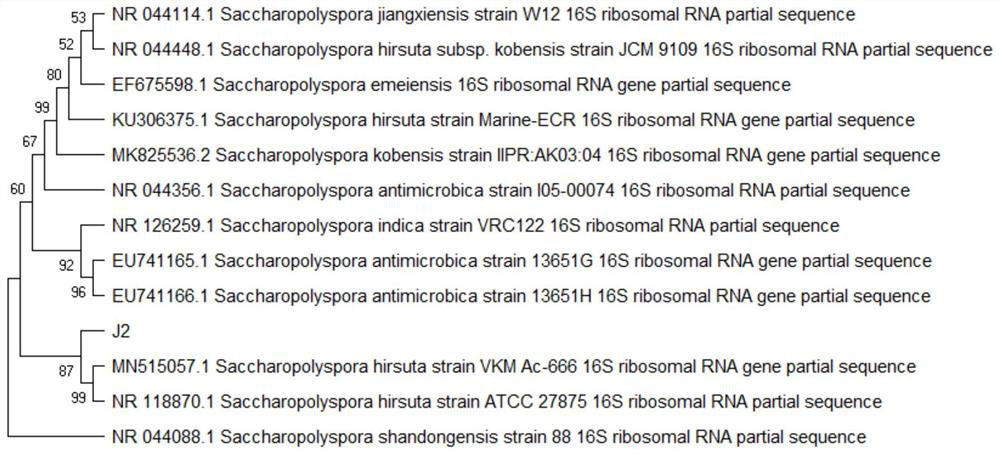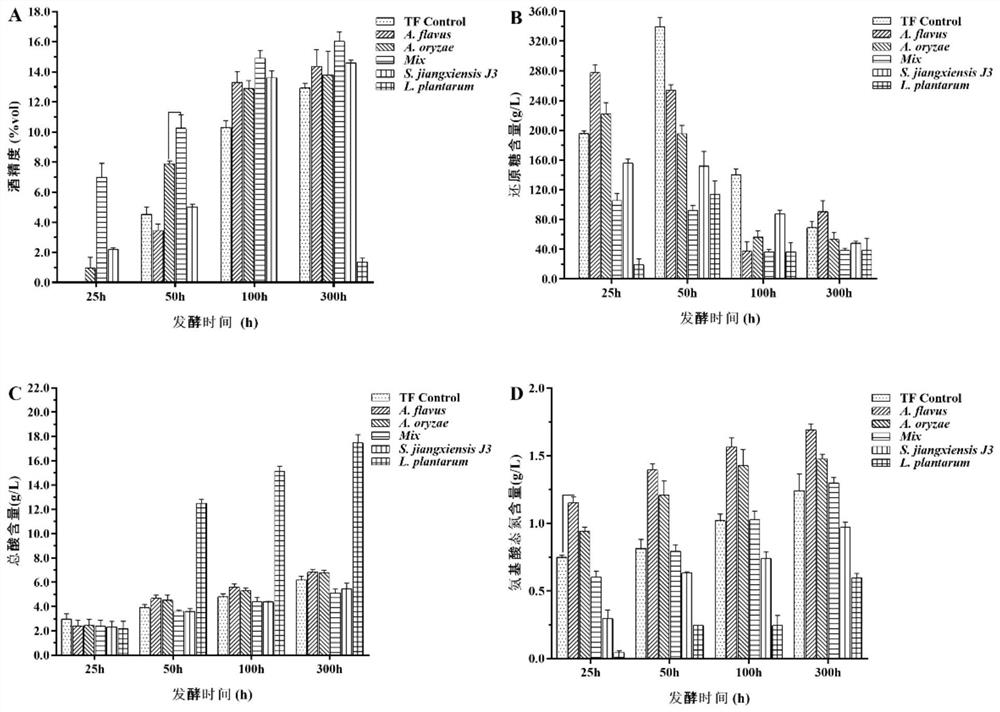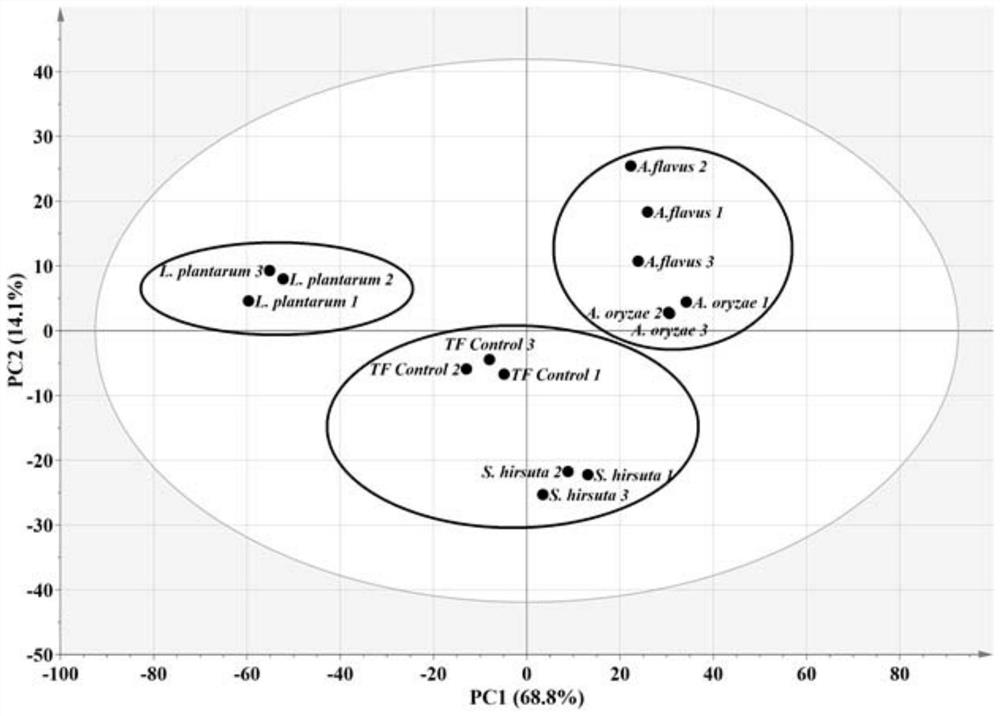Saccharopolyspora for decreasing biogenic amine and application of saccharopolyspora
The technology of polyspora and spores, which is applied in the field of food fermentation, can solve the problem of high content of biogenic amines, and achieve the effects of increasing the content of amino acids, increasing the content of amino acids and volatile substances in rice wine, and improving the quality of rice wine.
- Summary
- Abstract
- Description
- Claims
- Application Information
AI Technical Summary
Problems solved by technology
Method used
Image
Examples
Embodiment 1
[0054] Embodiment 1: Screening and identification of Saccharopolyspora
[0055] (1) Sample collection and pretreatment
[0056] The wheat koji samples were collected from a rice wine factory in Shaoxing City, Zhejiang Province, and the collected wheat koji were stored in sealed sterile plastic bags at 4°C. Weigh 5g of wheat koji into a 50mL centrifuge tube, add 30mL of distilled water and put it in a shaker incubator at 30°C for 30min.
[0057] (2) Plate screening of bacterial strains
[0058] Actinomycetes screening medium: potassium nitrate 1.0g / L, potassium dihydrogen phosphate 0.5g / L, magnesium sulfate 0.5g / L, ferrous sulfate 0.01g / L, sodium chloride 0.5g / L, soluble starch 20.0g / L, agar 15.0g / L, pH 7.2-7.4 (25°C).
[0059] Under a sterile operating environment, use a sterile pipette to draw 1mL of the sample into a 15mL sterile centrifuge tube, add sterile water to 10mL, mix well, and make 10 -1 homogeneous sample solution. Use a sterile pipette to pipette 10 -1 Put...
Embodiment 2
[0077] Embodiment 2: the activation culture of Saccharopolyspora hairis S.hirsuteJ2
[0078] Actinomycetes liquid medium: potassium nitrate 1.0g / L, potassium dihydrogen phosphate 0.5g / L, magnesium sulfate 0.5g / L, ferrous sulfate 0.01g / L, sodium chloride 0.5g / L, soluble starch 20.0g / L, pH 7.2-7.4 (measured at 25°C).
[0079] PDA medium: potato flour 6.0g / L; glucose 20.0g / L, agar 20.0g / L, pH 5.4-5.8, autoclaved at 121°C for 15min; solid medium was added on this basis.
[0080] MRS medium: beef extract 10g / L, peptone 10g / L, yeast extract 0.5g / L, glucose 20g / L, Tween 800.10g / L, sodium acetate 5g / L, dipotassium hydrogen phosphate 2g / L, citric acid Diammonium hydrogen 2g / L, magnesium sulfate 0.58g / L, manganese sulfate 0.28g / L.
[0081] Inoculate the Saccharopolyspora espativa J2 screened in Example 1 into the actinomycetes liquid culture medium with an inoculum size of 10%, and cultivate it on a shaker at 30° C. for 48 hours to obtain a first-grade seed liquid. Inoculate the act...
Embodiment 3
[0084] Embodiment 3: the preparation of pure wheat koji of Saccharopolyspora
[0085] (1) Wheat milling: the degree of crushing of wheat is 3-5 pieces per grain, with a small amount of powder, so that the wheat grain tissue is broken and the starch is exposed;
[0086] (2) Moisturizing: add about 35-40% clear water to the processed material in step (1), and stir for 20-25 minutes to make it fully and evenly absorb moisture;
[0087] (3) Retort sterilization: sterilize the material treated in step (2) at 121° C. for 30 minutes;
[0088] (4) inoculation: after the material of step (3) is cooled to 36 DEG C, inoculate the activated bacterial classification of embodiment 2, the concentration of inoculum solution is 10 5 ~10 6 cfu / mL, the inoculation volume is 5‰-15%.
[0089] (5) Keep the proper product temperature and room temperature after the koji material is put into the plate, and let it stand for about six hours.
[0090] a) Spore germination period: Six hours after the ...
PUM
 Login to View More
Login to View More Abstract
Description
Claims
Application Information
 Login to View More
Login to View More - R&D
- Intellectual Property
- Life Sciences
- Materials
- Tech Scout
- Unparalleled Data Quality
- Higher Quality Content
- 60% Fewer Hallucinations
Browse by: Latest US Patents, China's latest patents, Technical Efficacy Thesaurus, Application Domain, Technology Topic, Popular Technical Reports.
© 2025 PatSnap. All rights reserved.Legal|Privacy policy|Modern Slavery Act Transparency Statement|Sitemap|About US| Contact US: help@patsnap.com



